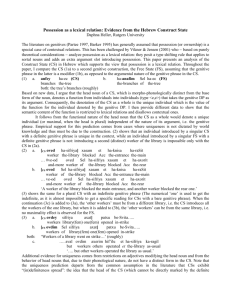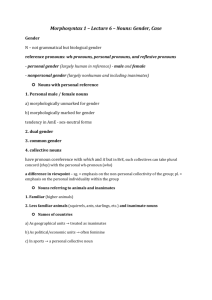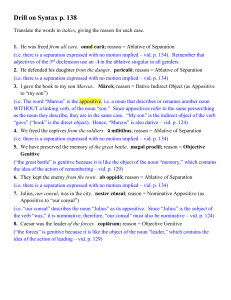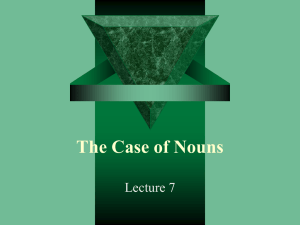§1 In Old English, a noun or a noun phrase inflected for Genitive
advertisement
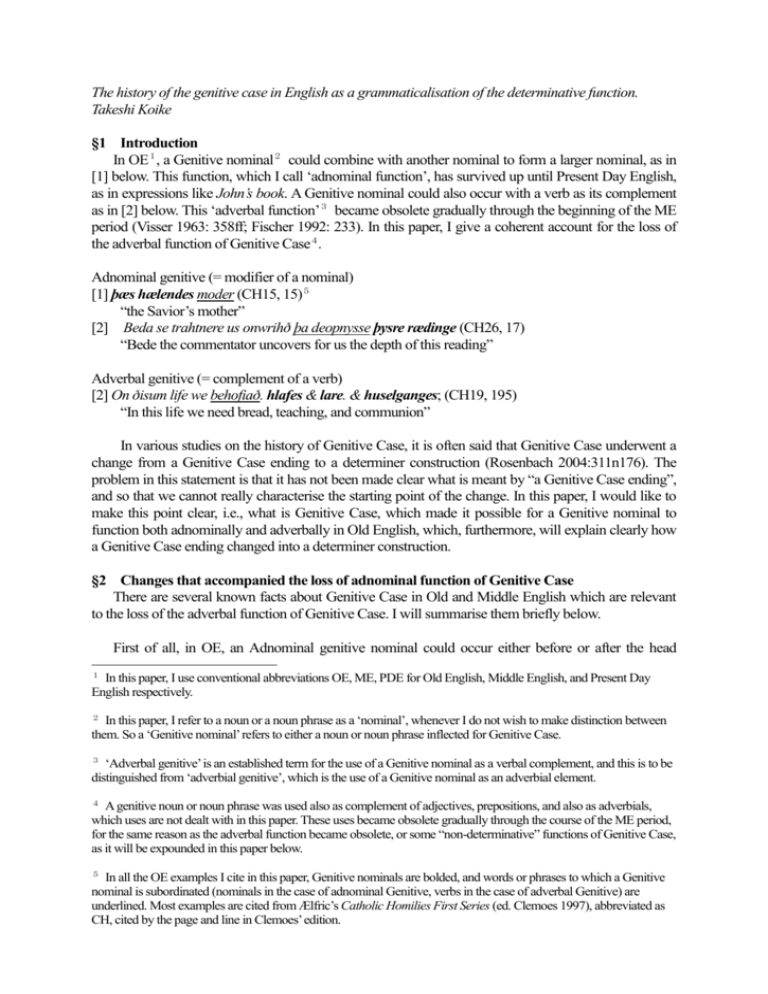
The history of the genitive case in English as a grammaticalisation of the determinative function. Takeshi Koike §1 Introduction In OE1, a Genitive nominal2 could combine with another nominal to form a larger nominal, as in [1] below. This function, which I call ‘adnominal function’, has survived up until Present Day English, as in expressions like John’s book. A Genitive nominal could also occur with a verb as its complement as in [2] below. This ‘adverbal function’3 became obsolete gradually through the beginning of the ME period (Visser 1963: 358ff; Fischer 1992: 233). In this paper, I give a coherent account for the loss of the adverbal function of Genitive Case4. Adnominal genitive (= modifier of a nominal) [1] þæs hælendes moder (CH15, 15)5 “the Savior’s mother” [2] Beda se trahtnere us onwrihð þa deopnysse þysre rædinge (CH26, 17) “Bede the commentator uncovers for us the depth of this reading” Adverbal genitive (= complement of a verb) [2] On ðisum life we behofiað. hlafes & lare. & huselganges; (CH19, 195) “In this life we need bread, teaching, and communion” In various studies on the history of Genitive Case, it is often said that Genitive Case underwent a change from a Genitive Case ending to a determiner construction (Rosenbach 2004:311n176). The problem in this statement is that it has not been made clear what is meant by “a Genitive Case ending”, and so that we cannot really characterise the starting point of the change. In this paper, I would like to make this point clear, i.e., what is Genitive Case, which made it possible for a Genitive nominal to function both adnominally and adverbally in Old English, which, furthermore, will explain clearly how a Genitive Case ending changed into a determiner construction. §2 Changes that accompanied the loss of adnominal function of Genitive Case There are several known facts about Genitive Case in Old and Middle English which are relevant to the loss of the adverbal function of Genitive Case. I will summarise them briefly below. First of all, in OE, an Adnominal genitive nominal could occur either before or after the head 1 In this paper, I use conventional abbreviations OE, ME, PDE for Old English, Middle English, and Present Day English respectively. In this paper, I refer to a noun or a noun phrase as a ‘nominal’, whenever I do not wish to make distinction between them. So a ‘Genitive nominal’ refers to either a noun or noun phrase inflected for Genitive Case. 2 ‘Adverbal genitive’ is an established term for the use of a Genitive nominal as a verbal complement, and this is to be distinguished from ‘adverbial genitive’, which is the use of a Genitive nominal as an adverbial element. 3 4 A genitive noun or noun phrase was used also as complement of adjectives, prepositions, and also as adverbials, which uses are not dealt with in this paper. These uses became obsolete gradually through the course of the ME period, for the same reason as the adverbal function became obsolete, or some “non-determinative” functions of Genitive Case, as it will be expounded in this paper below. 5 In all the OE examples I cite in this paper, Genitive nominals are bolded, and words or phrases to which a Genitive nominal is subordinated (nominals in the case of adnominal Genitive, verbs in the case of adverbal Genitive) are underlined. Most examples are cited from Ælfric’s Catholic Homilies First Series (ed. Clemoes 1997), abbreviated as CH, cited by the page and line in Clemoes’ edition. nominal it modified, or even split from it, as shown in the examples below. Prenominal genitive [4] þæs hælendes moder (CH15, 15) “the Savior’s mother” Postnominal genitive [5] moder þæs æmihtigan godes; (CH13, 110) “mother of the Almighty God” [6] ænne þyssera lytlinga (CH34, 153) “one of these little ones” Split genitive [7] AN angin is ealra þinga þ is god ælmihtig. (CH1, 6) “(There) is one beginning for all things, that is God Almighty” It has been reported that an Adnominal Genitive nominals denoting humans, especially definite humans tended to be preposed (Rosenbach 2002:178). The preposing of Adnominal Genitive nominal increases throughout the OE and ME period, and by the beginning of the fourteenth century, the postposed Adnominal Genitive disappears. The table given by Thomas (see Table 1) shows this change in position of a Genitive nominal, in relation to the periphrastic construction with the preposition of. Table 1 Summary of the data of adnominal genitive and of-genitive (in Thomas 1931:70). prose postnominal genitive periphrastic genitive prenominal genitive end 9th C. - begin.10th C. 47.5% 0.5% 52.0% latter part 10th C.- 30.5% 1.0% 68.5% begin.11th C. 11th C. 22.2% 1.2% 76.6% 12th C. 11.8% 6.3% 81.9% first half 13th C. 0.6% 31.4% 68.0% 14th C. 0.0% 84.4% 15.6% poetry begin. 8th C. - first half 9th C. 22.4% 0.3% 77.3% 12th C. 0.0% 19.2% 80.8% th first half 13 C. 1.0% 12.5% 86.5% latter half 13th C. 0.4% 28.6% 71.0% 14th C. 0.0% 50.7% 49.3% Secondly, Genitive Case in OE had different endings depending on the number, gender, declensional class, of the noun to which the Case ending is attached. Throughout the OE and ME period, the various endings were levelled to the uniform ending -es, regardless of the type of the noun to which it is attached (see Figure 1 below). Figure 1 Morphological variety of the Genitive endings and their reduction Singular -es (as in cyninges < cyning “king”) -e (as in giefe < giefu “gift”) -an (as in guman < guma “man”) -ø (as in fæder ø < fæder “father”) - (e)s -a (as in suna < sunu “son”) Plural -a (as in cyninga < cyning “king”) -ena (as in gumena < guma “man”) Thirdly, in OE, when a Genitive nominal consisted of the head noun and its various modifiers (demonstratives, possessives, adjectives), not only the head noun but also these modifiers were inflected for Genitive Case, as the formulas in Figure 2a show. Importantly, this distribution is the same for nominals inflected for the other cases (see Figure 2b). However, after the OE period, the genitive ending is attached only to the head of the Genitive nominal, so there is now only one position to show the Genitive inflection, i.e. the head noun of the Genitive nominal. Figure 2a Change in the distribution of the Genitive ending over elements within a noun phrase (cf. Seppänen 1997: 203). OE þæs lifiendan godes sunu [Demontrative-GEN ---- Adjective-GEN ---- Noun-GEN] [Noun] ME the living God's son [Demonstrative- --------- Adjective ------------ Noun-GEN] [Noun] Figure 2b Analogy of the distribution of the inflectional endings within a noun phrase of the different cases nominative genitive dative accusative [se lifienda god] [þæs lifiendan godes] sunu [þæm lifiendan gode] [þone lifiendan god] [Dem-Nom-----Adj-Nom-----Noun-Nom] [Dem-Gen-----Adj-Gen-----Noun-Gen] [Noun] [Dem-Dat-----Adj-Dat-----Noun-Dat] [Dem-Acc-----Adj-Acc-----Noun-Acc] Fourthly, in OE an Adnominal Genitive nominal could be combined with the head in a wide range of semantic or grammatical relationship, as the examples [8]-[15] below show. Here we have examples of interpersonal relationship, possessive relationship, those which function like adjective, partitive relationship, or there are examples in which a Genitive nominal carried a certain semantic role in relation to the verbal meaning of the head nominal, such as Agent, Patient, Experiencer, or Cause6. Of these various types of Adnominal Genitives, it is mainly those expressing Interpersonal relations, Possession, Agent, or (marginally) Patient that survived through to PDE, as the PDE translations show. A Genitive nominal with other kinds of relationship is now expressed by means of the of-phrase, as their PDE translations show. Adnominal Genitive nominals combined with the head in various semantic/grammatical relationships [8] Interpersonal þæs cildes fosterfæder (CH2, 192) “the child’s foster father” [9] Possession þæs rican mannes welan (CH13, 205) “the rich man’s wealth” [10] Descriptive hi wæron haliges lifes menn (CH30, 8) “They were men of holy life” [11] Partitive Behealdað þæt ge ne forseon ænne þyssera lytlinga (CH34, 153) “Watch out that you do not neglect one of these little ones” Semantic Role-based relationship [12] Agent þa wearþ he þurh hæþenra manna ehtnysse … gemartyrod. (CH30, 259) “Then he was martyred through heathen men’s persecution” [13] Patient for þigene þæs forbodenan bigleofan (CH7,251) “For the partaking of the forbidden food” [14] Experiencer His ærist wæs þæra engla blis (CH15, 99) 6 The examples [8]-[15] do not exhaust all possible relations that could be between the Genitive nominal and the head nominal. [15] Cause “His resurrection was a joy for the angels” & mid nanre fyrhte þæs toweardan wites (CH28, 117) “And with no fear of the coming punishment” Fifthly, Nunnaly (1985: 172) reports that when a Genitive nominal is placed before the head, and it consists of a noun and its own determiner (such as demonstrative or possessive), the head noun of the whole noun phrase will never have its own determiner. For example, with the example þæs hælendes moder, the genitive nominal þæs hælendes occurs before the head, and consists of a demonstrative and a noun. Accordingly, the head noun moder does not have its own determiner, so there is no example such as *þæs hælendes seo modor or *seo þæs hælendes moder7 attested in OE. On the other hand, if such a Genitive nominal is placed after the head noun, the head noun may (as in [16]) or may not be (as in [17]) accompanied by its own determiner, as the examples below show. [16] Beda se trahtnere us onwrihð þa deopnysse þysre rædinge (CH26, 17) “Bede the commentator uncovers for us the depth of this reading” (the head noun deopnysse ‘depth’ has its own determiner þa) [17] noes arc on yþum þæs micclan flodes hæfde getacnunge þyssere gelaþunge (CH35, 261) “Noah’s arch in (the?) waves of the great flood has signification of this church” (the head noun yþum ‘waves’ is not accompanied by a determiner) What this finding implies is that a preposed Genitive nominal with its own determiner functions as a determiner to the head, so the head noun does not need to be and in fact cannot be determined by any other extra determiner. But a postposed Genitive nominal did not necessarily determine the head noun, so if there need be, the head noun would have to have its own determiner. §3 Speculation about the grammatical status of a Genitive nominal Now, some generalisation will be made from these facts about the grammatical status of a Genitive nominal. First of all, in Figure 2b we saw that when a Genitive nominal consists of a noun and its dependents, the distribution of the inflectional endings is the same as that for a nominal inflected for the other cases. This fact suggests that a Genitive nominal has common property with a Nominative, Accusative, and Dative nominal, in that they are all NOMINALS (either a noun or a noun phrase). If a Genitive nominal is a Nominal, it explains why a Genitive nominal can be used as complement of a verb. Basically it can occur in syntactic contexts in which any other nominals could occur, such an Accusative or Dative nominal. Now, we have seen above a Genitive nominal functioning as a Determiner when it has its own determiner and placed before the head noun. A Genitive nominal, as well as being a Nominal, could also be a Determiner. From this I speculate more about Grammar of OE, that in OE there was not as clear distinction between Nominal Class and Determiner Class as in PDE. Here the distinction between function and category is important. In OE there are linguistic expressions which function like a “determiner” (here we need an independent characterisation of what constitutes a determiner function: see §5 below) such as demonstratives, possessive adjectives (e.g. min, þin), some indefinite pronominal adjectives (e.g. sum). However the category of “determiner”, which would have certain prototypical members characterised by some shared properties (cf. §5 below), was still yet to develop in OE. Because of this lack of the determiner category, it was possible for a Genitive nominal to “function” as a determiner, i.e. the same linguistic items could function in either way. Now, given that a Genitive nominal and other nominals share the common property in that they are 7 These are putative examples: if the head noun modor had its own determiner (say, a demonstrative), it would be the nominative singular feminine form seo. nominals, the next question is what differentiates between a Genitive nominal and non-Genitive nominals such as Nominative, Accusative, and Dative nominals. Despite the commonality between Genitive nominals and non-Genitive nominals, there is a very important difference between them: it is only a Genitive nominal that could appear both in adnominal and adverbal contexts. Especially Genitive’s adnominal function is highly productive. On the other hand, the occurrence of a Genitive nominal in adverbal context is semantically conditioned. How can we explain the differences between a Genitive nominal and a non-Genitive nominal? §4 Semantic value of Genitive Case The approach I take in answering this question is a semantic one. I argue that it is the difference in the semantic values of the Cases that makes difference in behaviours between a Genitive nominal and a non-Genitive nominal. Now, what are the semantic values of the Old English four Cases? In explaining the semantic values of the Cases, I refer to Roman Jakobson’s (1936) description of the Russian Case System. As far as I know, there is no study of Old English Genitive Case which systematically deals with Genitive Case in both its adnominal and adverbal functions. Jakobson’s account, in which he deals with both adnominal and adverbal functions of Genitive Case, is applicable to OE, since Genitive Case in Russian behaves in very similar way to Genitive Case in OE. But Jakobson’s account has been described as ‘highly abstract’ and so difficult to grasp (Wierzbicka 1980: xix; Taylor 1995: 143). So I simplify his theory by recasting it within a Cognitive Framework. First of all, I will clarify the notion of Case, and, more importantly, present Cognitive account of the notion of nouns. It is important to understand what a noun means, before embarking on the meaning of Case. After all, a Case marker is always attached to a noun, so what a noun means is an integral part of what a Case means. Here I will introduce Langacker’s “Billiard Ball Model” (Langacker 1991: 13ff) as a cognitive model for the prototypical meaning of a noun. Langacker claims that we conceive of the world as being populated by distinct physical objects moving about in space driven by energy and making contacts, as Billiard-Balls on a Billiard-Board. In this model of conception of the world, the discrete physical objects correspond to the prototypical semantic values of nouns, whereas energy corresponds to the prototypical semantic value of a verb. As for the meaning of Case, Langacker says, “Case markers are meaningful elements that combine with nominals to specify the nature of their involvement in a clausal process” (Langacker 1991: 384). Combining this notion of Case with the Billiard-Ball Model, Case is attached to a noun, and specifies how a physical object designated by the nominal participates in an event expressed by the sentence. Now Jakobson claims that Cases meanings can be characterised by certain semantic features. He introduces the following three features. [Directionality], [Marginality], and [Extent]. [Directionality] signals that the designated object is an end point of some energy flow, with the energy directed to it8. [Marginality] signals that the designated object lies in the margin of an event9. The feature [Extent] signals that the extent to which the designated object participates in an event is somehow limited10. These features are distributed as in Table 2. “Der Akkusativ besagt stets, daß irgend eine Handlung auf den bezeichneten Gegenstand gewissermaßen gerichtet ist“ (Jakobson 1936/1971:31) [The accusative always states that some activitz is directed to the referred object in some way (my translation)]. 8 “Der Randkasus gibt an daß das bezügliche Nomen im gesamten Bedeutungsgehalte der Aussage eine periphere Stellung einnimmt” (Jakobson 1936/1971:46) [The marginal case indicates that the relevant noun occupies a peripheral place in the entire meaning-content of the statement (my translation)]. 9 “Der G an sich besagt nur, daß der Umfang der Teilnahme des Gegenstandes am Sachverhalte der Aussage geringer als sein gesamter Umfang ist” (Jakobson 1936/1971:38) [The genitive in itself only states that the extent of the participation of the object into the situation narrated by the statement is smaller than its entire extent is (my translation)]. 10 Table 2 The distribution of the features in the Russian case-system: “+” indicates the presence of the feature11. Nominative directionality extent marginality Accusative + Genitive Dative + + + According to this table, Accusative Case signals that the object designated by an Accusative nominal is an end point of some energy flow, thus construed as some kind of PATIENT. Dative Case signals that the designated object lies in the margin of an event as well as being an endpoint of some energy flow. This makes a Dative object less prototypical candidate for PATIENT but more for EXPERIENCER. Because Accusative and Dative Case signal the object being an endpoint of energy source, they presuppose the presence of some energy source or some more salient entity. Nominative Case, having no semantic feature, does not signal anything about how the designated object is involved in a given event. For this reason a Nominative nominal is used primarily as a name. Unlike an Accusative or Dative nominal, a Nominative nominal does not presuppose the presence of some energy flow or energy source. For this reason, it can itself assume the role of some energy source like Agent, or some salient objects irrespective of semantic roles. Genitive Case, on the other hand, signals that the designated object participates in a given event to some limited extent. A Genitive nominal contrasts with other nominals by virtue of this feature [extent]. The main difference between Genitive and other Cases is that nominals in the other Cases designate objects as fully manifest: because these cases do not signal anything about the extent of their participation, by default they designate a fully participating object. On the other hand, in the case of Genitive Case, it positively signals the extent of participation. There are two semantic effects of Genitive Case. First of all, when a Genitive nominal is used with another nominal in its adnominal function, the conception of the two nominals will be a coherent single gestalt. This is because our attention upon the designated object of the Genitive nominal will be dislocated to the object of the other nominal. A Genitive nominal is useful whenever we want to mention two things or persons but conceive them as one single concept. A combination of a Genitive nominal and another nominal (as head), such as þæs hælendes modor can designate one ‘thing’; our attention is attracted to ‘mother’ (related to ‘the Saviour’ in the particular kinship), and not both ‘the Saviour’ and ‘mother’. If these noun phrases were a combination of two non-Genitive nominals (such as putative se hælend modor, they would refer to two ‘things’, i.e. ‘the Saviour’ and ‘mother’), and their designatum would not be a coherent concept. This is because these non-Genitive nominals designate (by default) fully participating objects, thus each of the two objects referred to attract a speaker/hearer’s full attention. This explains the productive and primary use of a Genitive nominal as a nominal modifier. On the other hand, when a Genitive nominal is used independently as complement of a verb, it designates a not-fully participating object, which has different variants depending on the semantic structure of the governing verb. With verbs denoting an activity which involves the decrease in quantity of some quantifiable object (such as ‘eat’, ‘drink’, ‘consume’), a Genitive nominal expresses an object of such activity as something decreasing in quantity. With verbs meaning ‘touch’, a Genitive nominal designates an object of touching as not affected by it (thus unprototypical PATIENT). With verbs meaning ‘need’, ‘wait for’, a Genitive nominal designates an object which is not present but expected to be realised (A thing one needs or waits for is not there yet, but expected to be). With verbs meaning ‘lose’, ‘stop doing’, ‘forget’, a Genitive nominal designates an object that is disappearing. Finally, a Genitive nominal appears in negative sentences to designate an object which does not 11 This table is drawn with reference to Bartschat’s (1998) review of Jakobson (1936). See Bartschat (1998:294). exist12. §5 Determinative function of a Adnominal Genitive nominal Now, given this characterisation of Genitive Case in OE, let us move on to the question of how some Genitive nominals assumed the Determiner function. Again I refer to Langacker’s analysis of determiner. He claims that the difference between Nouns and Noun Phrase is that Nouns specify a type of thing, whereas Noun Phrases specify an instance of the type specified by its head noun (Langacker 1991: 51ff). So, the noun cat specifies the type cat, but the object designated by this noun is not tied to any specific instance of it. On the other hand, noun phrases such as a cat or the cat anchors an instance of cat, either unknown or known to the speaker or hearer. Determiner function, then, can be described as anchoring of an instance of the type specified by the noun to which it is combined. Taylor argues that a PDE possessive construction functions as a determiner, using Langacker’s Reference Point Analysis (Langacker 1991:170). The Reference Point Analysis can be summarised as follows. Our conception of the world is populated by numerous objects, some are more salient than others (e.g. humans, especially known humans, are more salient than inanimate beings). When we wish to conceive of something that is relatively not salient, we first of all pick up some more salient entity that lies near the target entity. Using that entity as a reference point, we can reach the target entity. In this way, a Genitive nominal like þæs hælendes in þæs hælendes modor can be said to function as a determiner, because it anchors a specific instance of modor that is related to þæs hælendes (in this case, in kinship relation). In order for a Genitive nominal to function as a reference point, it has to be something salient to the speaker or hearer, such as humans, especially definite ones (known to both speakers and hearers). As we saw before, such Genitive nominals tended to occur before the head in OE. We might speculate that it was so placed in order to symbolise iconically the sequence of attention from the reference to the target entity. But another explanation is that such Genitive nominals were to join the newly emerging category of ‘determiner’ which would always be placed before the noun, as we see below. What seems to have happened from OE to ME is the emergence of a new structure of Noun Phrase, which consists of Determiner and Noun as its head13. Thus there emerged the new grammatical category of Determiner, and the distinction between Determiner Class and Nominal Class. At the beginning of the ME period, we see the development of the definite and indefinite articles (Fischer 1992: 217-8). The articles are prototypical members of Determiner Class. They have the following features: (1) It occurs at the beginning of a noun phrase; (2) it is invariant in forms, and (3) there is only one structural position for a determiner, and (4) it determines the head noun (i.e. anchors an instance of 12 Here are some examples of Adverbal Genitive. (With verbs meaning ‘eat’) Man slicð ðinne oxan beforan ðe, & þu his ne abitst. (Deutronomy 28:31) “Your ox will be slain before you, and you shall not not eat (of) it” (With verbs meaning ‘touch’) Ga hider near þæt ic æthine ðin (Genesis 27: 21) “Come here nearer so that I may touch you” (With verbs meaning ‘need’) See the example [3] in the text. (With verbs meaning ‘stop doing’) Min cild geswic þines wopes. (CH29, 39) “My child, stop your weeping” (In negative sentences) þ folc ne cuðe þæra goda þ hi cwædon þ he god wære. ac sædon þ he witega wære; (CH12, 144) “The people did not know the advantage that they (could have) said that he (= Jesus) was God, but (they) said that he was a prophet” 13 The new NP structure emerged as a system developed in which the definite/indefinite distinction of a nominal expression was shown by the article, whereas in OE and before, the distinction was often shown by the weak/strong declension of the adjective within an NP (Fischer 1992: 217). the type). When this new Noun Phrase structure was emerging, a Genitive nominal with the determinative function like þæs hælendes in þæs hælendes modor was reanalysed as a member of this newly emerged category of Determiner. It means that a Nominal consisting of a Genitive nominal and another nominal started to be analysed as one Noun Phrase consisting of a Determiner and a Noun. Genitive Case then started to resemble prototypical members of this Class (i.e. the articles), by obtaining the features (1)(2)(3) and (4). This explains the changes that happened to Genitive Case as we saw in §2 above, such as the fixation of the Genitive nominal position to the front of the noun, the levelling of the various Genitive endings to the uniform –es, and the reduction in the distribution of the Genitive endings. Accordingly, types of the adnominal genitive nominals which do not determine the head became obsolete, such as those functioning like an adjective (Example [9]), those expressing partitive relation (Example [11]), and those carrying certain semantic roles such as Patient ([13]), Experiencer ([14]), and Cause ([15])14. The emergence of Determiner Class as distinct from Nominal Class means that the same item cannot belong to both Determiner Class and Nominal Class, as it was possible in OE. Once a Genitive nominal is categorised as a member of Determiner Class, it ceased to be a Nominal any more, and it ceased to occur in all non-determiner contexts15. This is the reason why the adverbal function of Genitive Case became obsolete, and also why all non-determinative types of adnominal Genitive disappear from OE. In other words, the determinative function of Genitive Case, which was an occasional function of the Case, became generalised or grammaticalised as the sole function of the Case. §6 Conclusion A Genitive nominal was essentially a Nominal, as much as other inflected nominals were Nominals. This allowed a Genitive nominal to occur in various nominal contexts, one of which was a position for a complement of a verb. Because of the semantic value of Genitive Case [extent], it could occur with another nominal, to form a larger nominal structure, and also to occur with verbs and denote a non-prototypical participant of a given event. When a Genitive nominal is used with another nominal and function as a reference point (as when it denoted a definite human or humans), it assumed the determinative function. This was possible because in OE there was not a clear distinction between Determiner Class and Nominal Class, so the same Genitive nominal could function both Determiner-like and Nominal-like. At the outset of the ME period, there emerged the new structure of Noun Phrase, which minimally consisted of Determiner and Head Noun. A Genitive nominal gradually 14 The question of exactly why the subtypes of adnominal genitive nominals carrying these semantic roles became obsolete is a further topic. However it is important to note that Agent is a prototypical semantic role of a Subject NP, i.e. an external argument, whereas other roles, especially PATIENT, CAUSE, are prototypical roles for an Object NP, i.e. an internal argument. Internal arguments tend to specify a type of activity or state, whereas external arguments tend to specify a particular instance of them (e.g. there can be many instances of ‘eat bread’ (verb + direct object with the PATIENT role) or ‘fear the Lord’ (verb + direct object with the CAUSE role), and these verb phrases are infinite, i.e. not tensed. So the activity or state expressed by them are not anchored at a particular point in time. But these verb phrases combined with a subject NP, such as ‘I ate bread’ or ‘They feared the Lord’, with the tensed verb, do express a particular instance of the activity and state, anchored at a particular point in time. This might explain why the Genitive nominals bearing roles typically carried by a Subject NP tend to determine the head. 15 The non-distinct categorisation between Nominal Class and Determiner Class has a parallel in the domain of verb, i.e. Lexical verb Class and Auxiliary Verb Class (cf. Warner 1993; Hudson 1997). In OE, verbs such as cunnan and willan could be used either as a lexical verb when followed by a complement NP or as an auxiliary when followed by an infinitive form of a verb. This can be explained by assuming that in OE there was the function of auxiliary, but the category of auxiliary had not developed yet. After the end of the OE period, the evolution of the functional category ‘auxiliary’ starts and the category became more and more distinct from the lexical category of verbs to such an extent that the same verbs cannot be used for both functions. We might generalise what is happening in the domain of nouns and verbs as the emergence of the functional categories such as determiner and auxiliary. joined the newly emerged category of Determiner and started to resemble its prototypical members, namely the articles. The determinative function was grammaticalised as Genitive’s sole function, and all non-determiner-like functions, such as adverbal Genitive, became obsolete.
